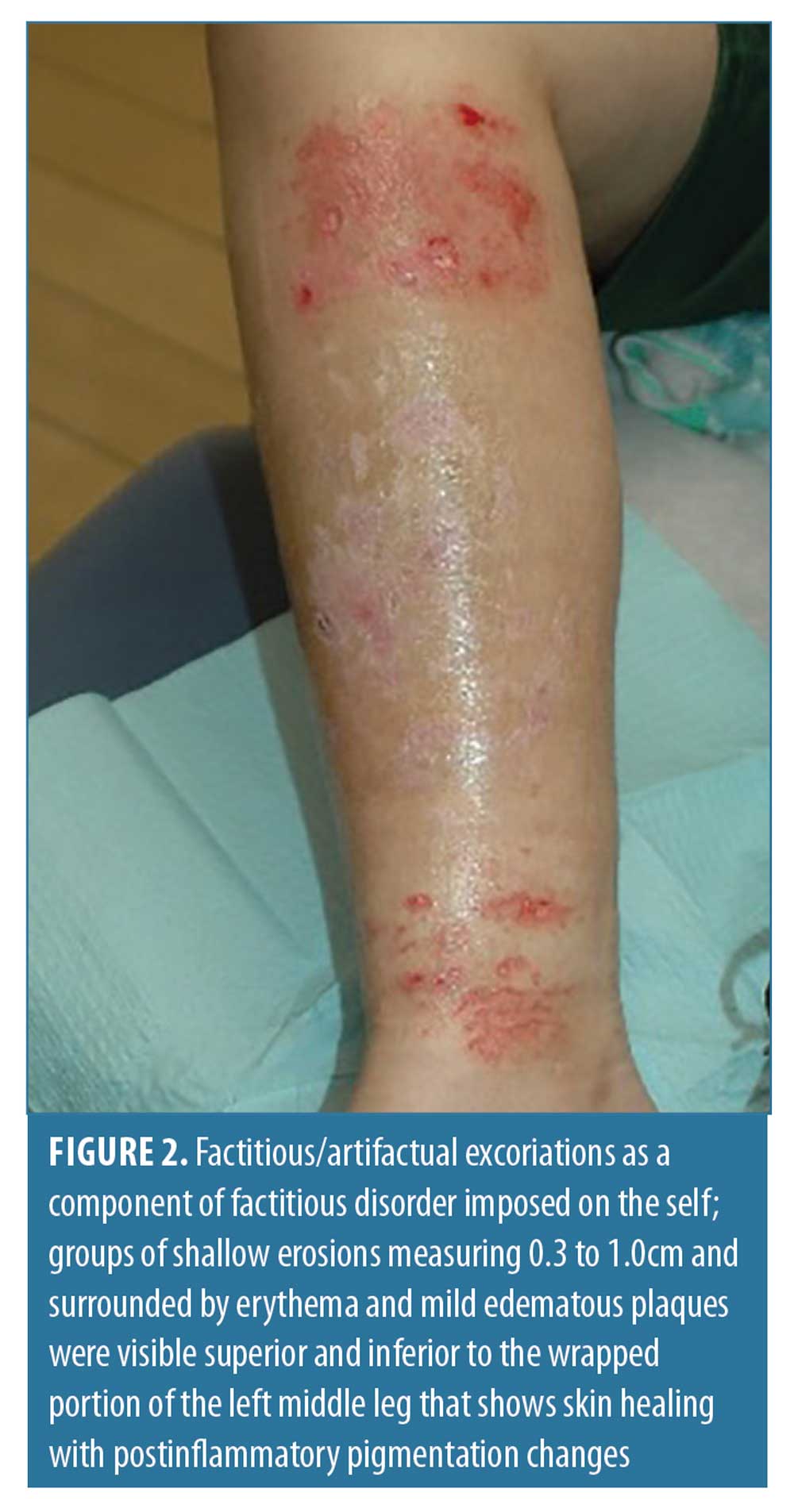 J Clin Aesthet Dermatol. 2021;14(5):22–24.
J Clin Aesthet Dermatol. 2021;14(5):22–24.
by Calvin Sung, MD; Secilia Salem, BS; Ethan Nguyen, MD; and John Koo, MD
Dr. Sung is with the Department of Dermatology, University of California Irvine in Irvine, California. Ms. Salem is with the University of California Riverside School of Medicine in Riverside, California. Dr. Nguyen is with Raincross Medical Center of Dermatology in Riverside, California. Dr. Koo is with the Department of Dermatology, University of California San Francisco in San Francisco, California.
FUNDING: No funding was provided for this article.
DISCLOSURES: The authors report no conflicts of interest relevant to the content of this article.
ABSTRACT: Factitious disorders and factitious disorders imposed on another are a prevalent encounter during dermatology visits. Here, we present a case of a pediatric patient who presented with ulcer-like lesions that, based on initial biopsy, suggested an immunobullous etiology. Further exploration revealed her underlying psychiatric disorder. Dermatologists play an integral role in recognizing and initiating “nervous system” management to establish a level of trust with the patient that will ultimately allow bridging to psychiatric care. The case discussed here serves as an example of the successful diagnosis and treatment of a pediatric psychiatric patient by raising clinical suspicion, using investigative techniques, employing separate interviews and the Patient Health Questionnaire-9, and sensitively addressing the relationship between the patient, guardian, and provider within the dermatology clinic.
Keywords: Munchausen syndrome, factitious disorder, munchausen syndrome by proxy, factitious disorder imposed on another, pediatric psycho-dermatology
Factitious disorder, previously known as Munchausen syndrome, is the typical diagnosis for a patient who self-inflicts wounds to gain sympathy from others.1 Factitious disorder imposed on another, previously known as Munchausen syndrome by proxy, occurs when pediatric patients and their parental figure purposefully present a patient as ill, impaired, or injured and interested in further diagnosis, treatment, and interventions.1 Unfortunately, patients with factitious cutaneous lesions are more likely to see and continue seeing a dermatologist while refusing psychiatric referral and primary care.1
Here, we present a case of a pediatric patient who presented with ulcer-like lesions that, based on initial biopsy, suggested an immunobullous etiology. Further exploration revealed her underlying psychiatric disorder. Pediatric patients make up a significant portion of total patients seen in dermatology practice, and cases such as the one presented here stress the duty of dermatologists to address patients and parents who require psychiatric treatment. This case highlights the role of dermatologists in managing psychiatric conditions with cutaneous manifestations in the interim prior to bridging care to psychiatry once a level of patient trust is established.
Case Report
A 14-year-old female patient, accompanied by her stepmother, was initially referred for a history of skin ulcer to rule out morphea per a primary care request, which showed postinflammatory pigmentation changes (Figure 1). The patient and stepmother initially reported a history of appendicitis and ear tubes and were primarily concerned with new erosions on the left anterior shin which they reported were unassociated with any trauma or excoriation. On examination, a 3×4cm erosion on the left shin was observed, with no signs of redness or inflammation, no firmness or induration on palpation, and scattered light brown macules on all four extremities. No improvement was observed with crisaborole 2% ointment given by the primary care physician; therefore, 20mg of prednisone daily was added for a suspected inflammatory flare of morphea with secondary excoriations while awaiting biopsy authorization. The patient presented two weeks later with more superficial erosions, prompting a differential diagnosis of artifactual excoriations versus pyoderma gangrenosum.

During a second visit, bacterial and viral panel results were negative and skin punch biopsies indicated subepidermal bullous change with neutrophilic and lymphoeosinophilic infiltrates, highly suggestive of bullous pemphigoid. The patient consequentially began receiving cyclosporine A (5mg/kg/day) and continued taking 20mg of prednisone daily for the presumptive diagnosis of blistering disease versus pyoderma gangrenosum. The patient was instructed to wrap the affected site to rule out suspected traumatic excoriation despite initial biopsy results.
The patient and her stepmother returned for a third visit within one week with multiple shallow erosions measuring 0.3 to 1.0cm and surrounded by mild erythema and edematous plaque on the left leg above and below the Unna boot, confirming the initial suspicion for self-induced lesions (Figure 2). Subsequent direct immunofluorescence study was negative, indicating bullous pemphigoid as an unlikely diagnosis, and a repeated biopsy of a new ulcer showed sharp necrosis of epidermis and superficial dermis with minimal inflammation, hinting physical trauma or artifactual excoriation.


The patient and her stepmother were interviewed separately and the patient was knowledgeable of her self-diagnosed multiple medical conditions. The stepmother reported that her stepdaughter was clinically diagnosed and being treated for attention-deficit/hyperactivity disorder, chronic seizures, and several other medical illnesses that she has seen other physicians for without proofs or studies. The Patient Depression Questionnaire-9 (PHQ-9) was administered and indicated that the patient had moderate-to-severe depression. She reported symptoms of formication on her arms and legs accompanied by a deep concern that “something may be crawling out of my skin,” suggesting a component of delusion of parasitosis. The patient and her stepmother independently reported that, four months ago, the patient’s dog had died, causing the patient to experience greater difficulty with concentration and prompting an increase in anxiety-depression episodes. Further interviewing revealed that the patient had a history of being neglected by her biological mother. The stepmother ultimately revealed that she was aware that the patient was inducing self-excoriations but played an empathic role by not volunteering this critical information.
The final impression indicated factitious disorder imposed on the self, complicated by a guardian who colluded with her daughter by allowing treatment with a potential risk of adverse events, thereby suggesting the psychodynamics of this case are similar to factitious disorder imposed on another, although the guardian was not formally diagnosed. The patient’s condition was further aggravated by underlying anxiety and depression and a component of possible delusions of parasitosis. Along with wound care instructions, an Unna boot was prescribed as an interim therapy to reduce excoriation. Close communication with the patient’s pediatrician was initiated and a referral to psychiatry was made with the patient’s consent by explaining that a component of the patient’s underlying disease likely stems from the “nervous system,” and the patient might benefit from psychiatric medications and psychotherapy in combination with dermatological follow-up.
Discussion
This case demonstrates the intricacies of managing factitious disorders in pediatric patients with presentations that are difficult to diagnose using usual investigative techniques.1 The PHQ-9 was employed to gauge the possibility of the excoriation being self-induced and fulfill the primary goal of the case, which was to ensure that the patient would not harm themselves throughout the course of treatment.2 Patients should be counseled on the connection between problems with their skin and underlying neurological etiologies, without overemphasizing the disease as psychiatric in nature to prevent antagonism. Once rapport is established and treatment is initiated, psychiatric involvement should be recommended as an expert consultant over neurological drugs to address underlying “nervous system” disease.3 Noninvasive diagnostic modalities, such as wrapping the patient’s legs and using an Unna boot with close follow up, should also be employed.
Concealing relevant medical history in order to gain the patient’s trust as portrayed by the guardian led to greater difficulty in reaching the proper diagnosis, considering the limited role that pediatric patients have within the dermatologist–parent consultation.4 However, in this case, the physician raised suspicion regarding clinical presentations, used investigative techniques, and employed separate interviewing techniques, all of which allowed for the correct diagnosis to be reached.5 Approximately 30 percent of all dermatology patients experience some form of a psychiatric disorder.6 The PHQ-9 is indicated to be used as a screening tool by any physician with a suspicion of patients with a personal or family history of psychiatric illness that might facilitate better patient care and collaboration with other providers. It is of utmost importance to use appropriate clinical judgment and precaution when administering the PHQ-9 in the dermatology setting to assess whether the patient has had any suicidal or homicidal ideations that require emergent intervention and hospitilization.7 For medical legal reasons, it is of utmost importance for consulting specialists, such as dermatologists, to closely communicate with the patient’s primary care provider to directly or indirectly instigate a referral to psychiatry, with each finding and decision supported by thorough documentation.
The resources and time necessitated by screening modalities, biopsies, complex history reviews, and separate patient–parent interviews often span hour-long sessions.8 The integration of teledermatology and teledermoscopy into psychodermatology cases can offer a practical alternative to maintain patient interaction beyond face-to-face visits, as illustrated by its success in other areas of dermatology, like the management of acne, eczema, and psoriasis.9
Conclusion
This case emphasizes the importance of a multi-specialty approach in establishing trust when treating patients presenting with factitious disorders. By employing the PHQ-9 and emphasizing a “neurological etiology,” proper rapport was established to ensure the patient’s medical needs were met.
References
- Boyd AS, Ritchie C , Likhari S. Munchausen syndrome and Munchausen syndrome by proxy in dermatology. J Am Acad Dermatol. 2014;71(2):376–381.
- Dey JK, Ishii M, Phillis M, et al. Body dysmorphic disorder in a facial plastic and reconstructive surgery clinic: measuring prevalence, assessing comorbidities, and validating a feasible screening instrument. JAMA Facial Plast Surg. 2015;17(2):137–143.
- Sung CT, Choi FD, Wang SH, et al. Nonantipsychotic therapies for delusions of parasitosis. Ital J Dermatol Venereol. 156(1): 95–96. Epub 2019 Feb 14.
- Hoffman JS , Koocher GP. Medical child abuse hidden in pediatric settings: detection and intervention. J Clin Psychol Med Settings. 2020;27(4):753–765.
- Parent DJ, Krafft T, Noel JC, et al. Cutaneous Munchausen syndrome with presentation simulating pyoderma gangrenosum. J Am Acad Dermatol. 1994;31(6):1072–1074.
- McDonald K, Shelley A, Jafferany M. The PHQ-2 in dermatology—standardized screening for depression and suicidal ideation. JAMA Dermatol. 2020;154(2):139–141.
- Picardi A, Adler DA, Abeni D, et al. Screening for depressive disorders in patients with skin diseases: a comparison of three screeners. Acta Derm Venereol. 2005;85(5):414–419.
- May P. Delusional health beliefs. Med Leg J. 2019;87(2):73–76.
- Lee KJ, Finnane A, Soyer HP. Recent trends in teledermatology and teledermoscopy. Dermatol Pract Concept. 2018;8(3):214–223.

